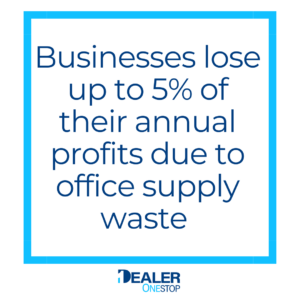With tight budgeting crucial in today’s business environment, certain cost factors can stealthily impact expenses. Office supply waste is such a masked adversary, discreetly consuming a significant portion of the company budget. Tiny outflows of expenditure for office items like pens, clips, or sticky notes might seem inconsequential individually, but collectively they sting.
Ironically, this surmounting cost often escapes the watchful eyes of supervisors. Citing a State of Flux’s 2022 survey, office supply waste accounts for a startling 15% of a business’s total supply expenditure — a figure that begs attention. Consequently, this accentuates the pressing importance of streamlining office supply procurement and inventory management, ensuring a more efficient and cost-effective budget allocation.
Procurement and Organizational Blindspots
Within the procurement area, several overlooked aspects contribute to abundant waste, often acting as organizational blind spots. In essence, overlooking regular audits or not maintaining an accurate inventory can lead to over-purchasing and eventual waste.
According to a study by Management Today, in 2022, almost 30% of companies accept the existence of procurement blindspots, fuelling office supply waste. These blindspots can range from habitual over-ordering offset by use-based procurement to underestimating the impact of such wastage on the bottom line. Alongside procurement, certain organizational practices also contribute to office supply wastage. For instance, a lack of adequate storage spaces or disorganized inventory leads to unnecessary repurchases. Additionally, the absence of staff training on the conservative use of supplies could add to the problem.
Tracing Employee Impact on Office Supply Waste
Unseen yet consequential, the role of employees in office supply waste is often underestimated. Companies typically overlook their employees’ minor yet impactful contributions in this sphere. Without realizing it, the employees’ unsupervised use of office supplies can culminate into substantial wastage over time that stealthily eats into the budget.
According to a 2022 report by Workonomix, a lack of awareness among employees contributes to nearly 20% of office supply waste. This underlines a critical point: employees’ unintentional yet costly misuse of supplies spells an issue. To combat this prevalent concern, staff education on the conservative use of supplies emerges as a feasible solution.
An effective response encapsulates organizations’ need to promote a mindful usage culture. There should be an emphasis on comprehensive training modules to guide the responsible use of supplies, plus the communication of savings to be accrued. As a side benefit, such initiatives reduce waste and push companies towards more sustainable practices,
Translating Excess to Lost Profits
Examining the financial side of the narrative, office supply waste can be translated to lost profits; a reality companies must confront. After all, every dime spent on purchasing and replenishing office supplies is a potential profit that could have been reinvested in the business if not for the waste. However, this true cost of waste is often masked by the seeming insignificance of individual items.
 According to the Association of Office Professionals’ 2022 study, businesses can lose up to 5% of their annual profits due to office supply waste. Notably, this percentage can mean substantial sums for larger businesses. Therefore, addressing supply waste becomes not just about saving expenses, but also optimizing profit margins.
According to the Association of Office Professionals’ 2022 study, businesses can lose up to 5% of their annual profits due to office supply waste. Notably, this percentage can mean substantial sums for larger businesses. Therefore, addressing supply waste becomes not just about saving expenses, but also optimizing profit margins.
As a response, organizations should revamp their procurement strategies to focus on need-based purchases and effective inventory management. They must understand that every small saving in office supplies is an addition to their profit. Emphasizing regular audits, predictive analyses, and waste reduction programs can pave the way for a more efficient, profitable business model. In the long run, these strategies can have a significant, positive impact on the company’s bottom line.
Revamping Office Supply Management
Steadily climbing up the priority ladder, office supply management reform appears to be the need of the hour. A considerable chunk of waste can be avoided merely by reforming office supply management — a practice that has been historically undermanaged and overlooked in many businesses.
A thought-provoking statistic from Procurement Leaders 2022 sheds light on the extent of potential improvements: businesses adopting modern management strategies saved up to 20% on their office supply spending. Organizational changes such as accurately tracking usage, maintaining an organized inventory, and improving the procurement process can play a pivotal role in achieving this goal.
Organizations must embrace the significance of employee inclusion in this reform. By instilling an understanding of responsible consumption and waste reduction, capable utilization of supplies can become the norm, rather than the exception. Employee-led initiatives, regular audits by team leads, and reward systems for minimal waste are some of the strategies that businesses can adopt. Such systematic changes, while requiring upfront effort, promise an efficient and sustainable office environment in the long run.
Perhaps the biggest step forward an auto dealership can make in revamping its office supply management is signing up for the Dealer One Stop Staples Business Advantage Program. Not only will this program help an auto dealership track supply expenses and save the dealer money, but it will also streamline their procurement process, saving a car dealership time and helping to avoid supply management issues.








